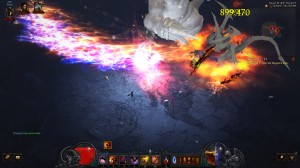If you’ve read my posts, then you know that I’m a huge fan of progression systems in game design. Some examples would be meta-game, player-based, abstraction and so on. Upgrading characters has been a popular means of adding abstracted progression. However, understanding how to handle progression systems correctly can mean the difference of how your game will turn out.
Building Up:
As always, let’s start by defining our topic. Upgrade systems in game design are a form of abstracted progression. Here, the player’s core stats or abilities are weak to begin with, but can grow overtime. This is not an example of mechanic-based progression or Metroidvania design, because those actually change how the game plays.
Upgrades simply make it easier/better for the player to perform the basic tasks of the game, and new options can unlock over time. There are many, many, examples of upgrade systems in games. Typically, we see them in action or skill-based games as a way to tie a layer of abstracted progression to a skill game.
The Dead Rising series makes heavy use of upgrade systems; with each experience level in Dead Rising raising a core stat of the player. The main point about upgrades is that playing the game gets easier the longer you play. At the start, you may have little health, can only hold a few items and move slowly; by the end, you can tank damage, have a closet full of inventory space and can run like a track star.
Using upgrade systems as a form of progression is another tool in the designer’s tool kit to keep the player invested in the game.
The fact that the player can both see and feel the difference in their character works amazingly well as a form of progression.
However, not every game can support upgrade systems, and they can do more harm than good if you’re not careful.
The Power Minutiae:
In order for abstracted progression to work, it has to be meaningful. Every choice should have value to the player and how they play the game, and no one choice should be superior.
An often seen problem of upgrade design is when designers overwhelm the player with choices. You have major ones like: Health, Damage and Defense; paired with odd choices like: Ammo capacity, zoom in speed, reload times and so on.
The point is that these kinds of upgrade systems present false choices to the player. If you had the choice to make your gun do 50% more damage or decreases reloading by half a second, which one would you do? Little choices can help the player, but you don’t pair them with core abilities.
In The Evil Within, the upgrade system is all over the place in this regard. You have major choices like increased stamina, health and damage, next to reducing weapon sway or holding more bullets.
What’s worse is that this can create a trap for the player that makes the game harder in the long run.
When dealing with heavy enemies, you need extra stamina to keep on the move. Prolonging the upgrade will make the game a lot harder for players who invested in the other upgrades first.
The designers have different costs associated with the upgrades, but they’re all tied to the same resource. The smart player would save up for the most important upgrades first, rather than upgrading everything evenly. There are so many upgrades that you literally can’t upgrade them all over the course of playing.
Doom was wise in this regard. The upgrades were split between different types and different resources; making sure the player was never limiting themselves by spending too much.
The Downward Slope:
If the upgrade system is not integrated right, it can cause another problem. Going back to the false choice point, it’s very possible for the player to screw themselves with not making the right choices. If you balance your game around the player choosing X options to upgrade, the game could become unbeatable if they go another way.
Compounding the problem, if your upgrade system has no way to redo choices, the player could go down the wrong path from the very beginning. Nothing kills a player’s engagement more than realizing that they made all the wrong choices and must completely restart the game.
One weird issue we see is when a game’s difficulty curve is inverse because of the upgrade system. At the start, the player will have a hard time playing due to lack of health and power.
Over time, the game becomes easier, because the player is now stronger in terms of abstraction. I’ve only ran into a few games that had this issue, like God Hand and Ninja Gaiden Black, and it’s debatable if this is an example of poor design.
Getting around the problem of upgrade systems requires a fine touch, and there are a few examples we can go over.
Useful Upgrading:
The first point should be obvious: If you have an upgrade system, then there should be enough ways to fully upgrade the player over the course of play. If the discerning player spends their time hunting for everything, they should be rewarded with enough ways to fully upgrade their character.
Even then, if you have major upgrades that are available, the player should be able to get them all through normal play. It’s important to figure out what are your major and minor upgrade paths. Major upgrades are the ones that directly impact playing the game (damage, health, defense), while minor ones are quality of life improvements (ammo capacity, walking speed, snap to zoom).
Either have all major upgrades or all minor upgrades, but don’t mix them into the same system. If you do decide to have a set number of resources for upgrades, make sure to include a respec option. The reason should be obvious: It prevents punishing the player and lets them experiment.
Not only that, but it has the passive effect of making those upgrade points more meaningful, because the more they have, the more they can do with their character.
If you want the player to experiment, then there has to be insurance that they won’t get stuck with a poor build.
Many designers use a new game+ to let the player continue upgrading.
The problem with that approach is you cannot expect someone to play through your game multiple times. Often, this measure will break any kind of challenge you set up for new game +. Unless you create new situations, a fully upgraded character will not have any problems.
Proper Progression:
Making the player better through upgrade systems seems like an easy win for the designer. However, any system not balanced right can lead to trouble and hurting the design. Not every game needs upgrade systems for player progression.
If the player is always going to get specific choices because of their utility, then the upgrade system is moot. If every choice is great, and it’s a matter of deciding the order, that’s not as bad.
In the Ghostbusters ’09 game, every upgrade was a direct improvement. Even though some were better than others, there was no one perfect choice above all else. A skilled player would get them before the end of the game, and that’s fine. Regardless of skill level, you’re going to get them all eventually.
As a designer, you need to figure out whether you have major or minor upgrades set up. Always assume the player is going to go after the major ones, and possibly get around to the minor upgrades. If you can’t get the major upgrades, then there is a problem with your progression model.
Get the progression model right and you can keep the player engaged from start to finish. And if you do your job correctly, the player will feel like a fully-upgraded bad-ass.
Stay tuned for an upcoming post, as we still need to delve deeper into quality of life upgrades.
If you enjoyed this post, please consider donating to the Game-Wisdom Patreon campaign. Your donations can help to keep the site going and allow me to produce more great content. Follow me on Twitter @GWBycer, and you can find daily video content on the Game-Wisdom YouTube channel.





